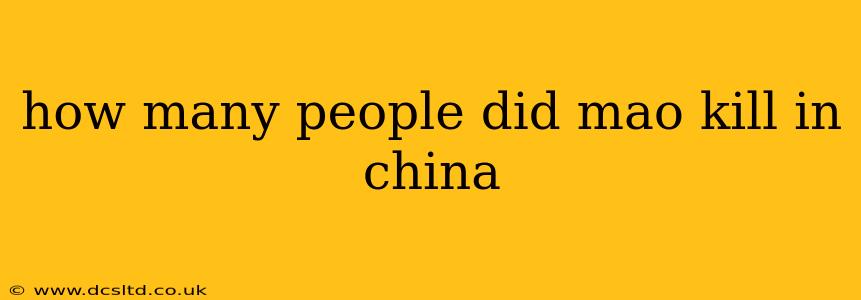How Many People Did Mao Kill in China? The Unbearable Weight of a Complex Question
The question of how many people Mao Zedong killed in China is a deeply complex and controversial one, lacking a single, universally accepted answer. There's no official death toll, and the available figures vary wildly depending on the source and methodology used. The sheer scale of the events under Mao's rule, coupled with the deliberate destruction of records and the inherent difficulty in attributing deaths directly to specific policies, makes establishing a definitive number virtually impossible. However, understanding the various contributing factors allows for a more nuanced and informed perspective.
It's crucial to avoid simplistic statements that assign a single number. Instead, we need to consider the various causes of death during Mao's reign (1949-1976) and analyze their relationships to his policies.
What are the different estimates of deaths under Mao's rule?
Estimates of deaths attributable to Mao's rule range from tens of millions to upwards of 70 million. These vastly different numbers stem from several factors:
- Methodology: Some researchers focus on excess mortality compared to pre-Mao or post-Mao periods. Others attempt to directly link specific deaths to particular policies. These differing approaches yield drastically different results.
- Data Availability: The Chinese government has never released comprehensive data on population losses during this period. Much of the evidence is anecdotal, based on fragmented records, and subject to varying interpretations.
- Attribution: Distinguishing deaths directly caused by government actions from those indirectly resulting from famine, disease, or other factors is incredibly challenging. For example, the Great Leap Forward (1958-1962) resulted in widespread famine, leading to millions of deaths. While Mao's policies directly contributed to this famine, attributing every death solely to him is an oversimplification.
What were the main causes of death during Mao's era?
Several factors contributed to the immense loss of life:
- The Great Leap Forward: This disastrous economic policy aimed at rapid industrialization resulted in widespread famine, leading to an estimated 15-55 million deaths. The mismanagement of agricultural production, forced collectivization, and the suppression of dissenting voices were key contributing factors.
- The Cultural Revolution (1966-1976): This decade of political turmoil led to widespread violence, persecution, and social upheaval. Millions died due to execution, torture, forced labor, and starvation. Precise figures remain difficult to ascertain.
- Political Purges and Campaigns: Throughout Mao's rule, various political campaigns targeted perceived enemies of the regime. These campaigns resulted in mass executions, imprisonments, and the deaths of countless individuals.
- Famine and Disease: Poor economic policies, coupled with disruptions to agricultural production, exacerbated existing problems of famine and disease, significantly increasing mortality rates.
How can we better understand the scale of the deaths?
It's essential to acknowledge the limitations of available data and the inherent complexity of assigning blame. Rather than focusing on a single, potentially inaccurate number, it's more productive to study:
- The specific policies and campaigns: Analyzing the impact of individual policies such as the Great Leap Forward and the Cultural Revolution provides a clearer understanding of the mechanisms that led to mass casualties.
- The experiences of survivors and victims: Oral histories and personal accounts offer valuable insights into the human cost of Mao's rule, often neglected in broader statistical analyses.
- The broader historical context: Understanding the social, economic, and political conditions of the time is crucial for interpreting the available data and assessing the responsibility of various actors.
In conclusion, while providing a precise number of deaths attributed to Mao is impossible, understanding the various contributing factors and avoiding simplistic claims is vital. The legacy of his rule remains a subject of ongoing historical debate and research, demanding careful consideration and a nuanced approach. The scale of suffering and loss of life under Mao's rule was undeniably immense, and its impact continues to resonate in China today.
